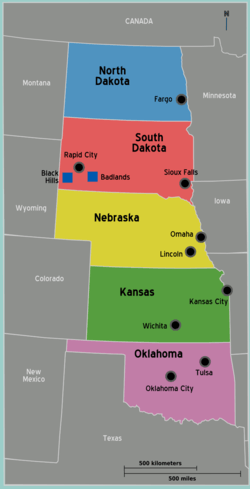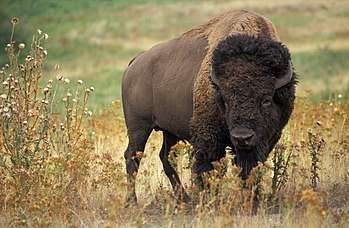Great Plains
The Great Plains of the United States of America is a wide open grassland between the Rocky Mountains and the forests of the Midwest. While most of the land consists of farms and pastures, the Great Plains are also home to the Badlands and Black Hills, with the iconic Mount Rushmore.
States

| North Dakota For travelers interested in going off the beaten path, it offers outdoor activities, scenic nature, and Native American holy sites—as well as a recent oil boom. |
| South Dakota Known for the Badlands and Black Hills, including Mount Rushmore, and for its Native American sites. |
| Nebraska Nebraska has a reputation of being a flat, monotonous region of farm and ranch land, but those who venture off the heavily traveled Interstate 80 corridor discover that Nebraska does have a subtle, wide-open beauty that is all its own. |
| Kansas Located in the geographic center of the country, Kansas is particularly appealing if you are interested in the history of the American West. Also famous for being the "no place like home" that Dorothy wants to return to in "The Wizard of Oz". |
| Oklahoma A rich Native American past and continuing pioneer spirit. |
Paralleling the Rocky Mountains, this vast stretch of grasslands extends from a tiny pocket of northern Mexico, through Texas and all the way north to the Canadian provinces of Alberta, Manitoba and Saskatchewan. (Northeastern New Mexico, the eastern half of Colorado and Wyoming, large parts of Montana, southwestern Minnesota, the northern half of Iowa and even extreme northwest Missouri are geographically part of the Great Plains, but they are covered in other region articles.)
Cities
- 🌍 Fargo
- 🌍 Kansas City, Kansas – a city that straddles the border between Kansas and Missouri
- 🌍 Lincoln
- 🌍 Oklahoma City
- 🌍 Omaha
- 🌍 Rapid City — near the Black Hills of South Dakota
- 🌍 Sioux Falls
- 🌍 Tulsa
- 🌍 Wichita
Other destinations

- 🌍 Badlands National Park — a multitude of cliffs and canyons
- 🌍 Black Hills National Forest — one of the few mountainous areas on the Great Plains
- 🌍 Chimney Rock National Historic Site
- 🌍 Jewel Cave National Monument
- 🌍 Mount Rushmore National Memorial — four presidents' faces carved into a mountain
- 🌍 Scotts Bluff National Monument
- 🌍 Theodore Roosevelt National Park
- 🌍 Standing Rock Indian Reservation
Understand
While some on either coast might label this part of the country "flyover country" it is not without charms, especially in terms of nature and wildlife. Mount Rushmore, the Native American heritage and the spirit of the Old West are part of the cultural charms of this region.
Talk
English is by far the most spoken and widely understood language. Historically indigenous American languages were spoken by many in this area, but nowadays those that speak them will usually also speak equal if not better English. Historically this was one of the areas with the most German heritage, but the use of German as a first language died out during the World Wars when it was seen as unpatriotic and arose (sometimes justified) suspicions of imperial or Nazi sympathies. Today few people speak anything above and beyond a few words of German.
Get in
By plane
- See also: air travel in the USA
Air-travel is fastest and probably the most practical way of entering the Great Plains region. Many smaller cities in this region are serviced by the Midwestern airport hubs of Chicago (ORD IATA and MDW IATA), Kansas City, MO, or Minneapolis, Western hub Denver, or Texan hubs Dallas and Houston. From those large airports, smaller commuter flights are available into many small city airports such as Fargo or Grand Forks, North Dakota; Rapid City or Sioux Falls, South Dakota; Omaha, Lincoln, Grand Island, Kearney, McCook, Scottsbluff and Alliance, Nebraska; Salina, Wichita or Topeka, Kansas; and Tulsa or Oklahoma City, Oklahoma.
By train
Amtrak serves part of this region. While trains are often not much faster than buses (if that) and usually not cheaper than flying for all but the shortest trips what they offer in views, legroom and sheer style of travel at least to some more than make up for those downsides and thus Amtrak has posted record riderships for most of the years since 2000.
By car
Most of the region is connected to the interstate highway system. Some roads in rural areas are in a very bad state however.
By bus
Intercity buses in the US
Get around
By car
Generally by automobile. On the whole, this is one of the worst regions for touring the United States without a car.
By train or bus
Greyhound bus has several routes through here as well and there is very limited passenger rail service.
By plane
Many larger cities have regular air-commuter service to larger hub airports. Smaller towns may have smaller commuter flights with more limited service.
See
The Great Plains is not packed with sights. In fact, it's not packed with much of anything—these are some of the lowest density states in the union, iconic for their wide, flat, open spaces. The largest cities of Kansas City, Oklahoma City, Tulsa, and Omaha all have a number of modest attractions, although a visitor to the United States probably wouldn't go out of their way to find them. The one big exception, however, are the Black Hills and Badlands of southwestern South Dakota, which is home to several of quite literally the country's biggest attractions: in particular, Mount Rushmore National Memorial and Crazy Horse Memorial, as well as an enormous range of rugged and mountainous terrain, filled with Wild West cowboy towns and big game animals.
Nature
- Great numbers of wildlife can be observed here including Whitetail deer, otters, badgers, pronghorn, prairie dogs, coyotes as well as Elk and Buffalo in wildlife refuges as well as other managed areas
- Theodore Roosevelt National Park in Western North Dakota
- Badlands National Park in Western South Dakota
- Black Hills National Forest in Western South Dakota
- Sandhills in North Central Nebraska
- Many National Grasslands dot this region
Itineraries
Do
- Visit County/State Fairs generally occurring during the fall months, admission is usually charged
- Rodeos
- Horseback riding
- Wildlife Viewing
- Museums
- Storm chasing
- Hiking
- Fishing (licenses required, purchased at sports shops and larger stores such as Wal-Mart or grocery stores in the region)
- Hunting (licenses required, hunters safety requirements vary by state)
Eat
Drink
- Free Ice Water at Wall Drug, Wall, South Dakota
Stay safe
The Great Plains are the location of "Tornado Alley", a multi-state region where tornadoes are more frequent on average during the spring and summer months. See Tornado safety for more information. While it is somewhat rare for tourists to experience tornadoes, severe thunderstorms containing frequent lightning, strong winds, hail and heavy rains are common during the spring and summer months as well. When weather conditions deteriorate listen to local radio stations for information ("Weather Radio Information" roadsigns are fairly common on interstates) The northern areas of this region are susceptible to blizzards and bitter cold temperatures during the winter; while southern regions sometimes face severe ice events. When driving cross-country in the winter, be prepared as Interstates often close during severe winter weather events.
Due to the rural nature of most of the region, gun ownership is very common in the Great Plains, and hunting is a popular pastime for many residents. Gun owners are generally responsible with their weapons, but be sure to wear bright colors when hiking in the wilderness so you do not get mistaken for a wild animal. Be very careful not to take shortcuts across privately owned land, as incidents have happened where property owners shot trespassers.
Go next
To the north lie the Prairies of Canada.